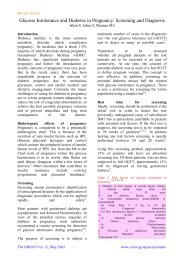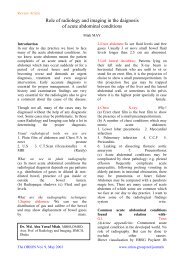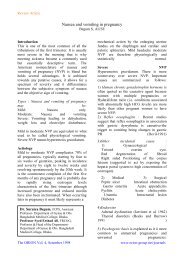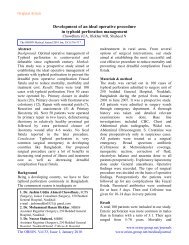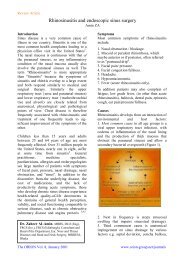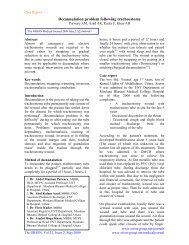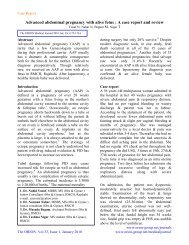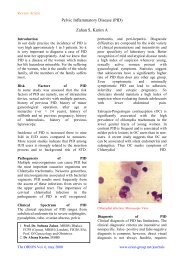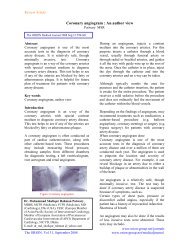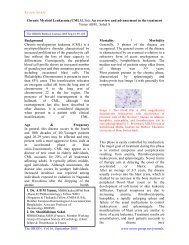Emergence of dengue haemorrhagic fever in ... - Orion Group
Emergence of dengue haemorrhagic fever in ... - Orion Group
Emergence of dengue haemorrhagic fever in ... - Orion Group
Create successful ePaper yourself
Turn your PDF publications into a flip-book with our unique Google optimized e-Paper software.
Review Article<br />
<strong>Emergence</strong> <strong>of</strong> <strong>dengue</strong> <strong>haemorrhagic</strong> <strong>fever</strong> <strong>in</strong> Bangladesh: Diagnosis,<br />
management and prospects for control<br />
Rahman M, Siddique AK, Rahman K<br />
Introduction<br />
Dengue is an acute febrile mosquito-borne<br />
disease caused by four antigenically related<br />
viruses serotypes <strong>of</strong> <strong>dengue</strong> <strong>in</strong> tropical and<br />
subtropical areas <strong>of</strong> the world putt<strong>in</strong>g more<br />
than 3 billion people at risk <strong>of</strong> <strong>in</strong>fection. An<br />
estimated 5O -lOO million <strong>of</strong> <strong>dengue</strong> cases<br />
occur yearly result<strong>in</strong>g <strong>in</strong> 500,000<br />
hospitalisation and 25,000 deaths. The patterns<br />
<strong>of</strong> <strong>dengue</strong> viral diseases vary and <strong>in</strong>clude<br />
commonly mild undifferentiated <strong>fever</strong>,<br />
classical <strong>dengue</strong> <strong>fever</strong> (DF) and lifethreaten<strong>in</strong>g<br />
<strong>dengue</strong> <strong>haemorrhagic</strong> <strong>fever</strong> (DHF)<br />
frequently lead<strong>in</strong>g to hypovolemic shock i. e.<br />
<strong>dengue</strong> shock syndrome (DSS) with a<br />
significant case-fatality rate up to 44% if early<br />
diagnosis followed by careful and timely<br />
proper case-management are not performed.<br />
Classical <strong>dengue</strong> <strong>fever</strong> is characterised by<br />
<strong>fever</strong>, pa<strong>in</strong> symptoms (headache, muscle and<br />
jo<strong>in</strong>ts pa<strong>in</strong>, retroorbital pa<strong>in</strong>), rash and<br />
gastro<strong>in</strong>test<strong>in</strong>al symptoms (vomit<strong>in</strong>g, nausea,<br />
loss <strong>of</strong> appetite and diarrhoea). The febrile<br />
phase is usually followed by a short afebrile<br />
phase ( defervescence phase) and a relatively<br />
long convalescence phase. Between 1635 and<br />
1886, <strong>dengue</strong> <strong>in</strong>fection was primarily<br />
cl<strong>in</strong>ically expressed as relatively mild <strong>dengue</strong><br />
<strong>fever</strong> without a significant morbidity and<br />
mortality <strong>in</strong> the world. However, <strong>dengue</strong> cases<br />
with haemorrhage, shock and death were<br />
reported for the first time <strong>in</strong> 1887 <strong>in</strong><br />
Queensland, Australia. The severe nature <strong>of</strong><br />
DHF was not well recognized till 1953 when a<br />
large epidemic <strong>of</strong> DHF (Philipp<strong>in</strong>es <strong>fever</strong>)<br />
occurred <strong>in</strong> Manila, Philipp<strong>in</strong>es. The epidemic<br />
1. Mahbubur Rahman, MBBS, MSc, Ph. D<br />
(Dist<strong>in</strong>ction), Associate Scientist, Laboratory<br />
Sciences Division ICDDR,B. Dhaka,<br />
Bangladesh, E-mail: mahbubur @ icddrb.org,<br />
2. A. K. Siddique, MBBS, MPH, Senior<br />
Scientist. ICDDR,B. Dhaka, Bangladesh.<br />
3. Khalilur Rahman, MBBS, MRCP (UK),<br />
Senior Consultant, Department <strong>of</strong> Medic<strong>in</strong>e,<br />
Holy Family Red Crescent Hospital, Dhaka.<br />
rema<strong>in</strong>ed localized <strong>in</strong> Southeast Asia till the<br />
1970s <strong>in</strong>volv<strong>in</strong>g Thailand, Myanmar and other<br />
neighbour<strong>in</strong>g countries. In the 1980s and<br />
1990s the epidemic DHF spread west <strong>in</strong>to<br />
India, Pakistan, Sri Lanka, Maldives and<br />
probably Bangladesh and east <strong>in</strong>to Ch<strong>in</strong>a.<br />
Nearly 30 years after its appearance <strong>in</strong> Asia,<br />
the first epidemic DHF emerged <strong>in</strong> the<br />
Americas <strong>in</strong> Cuba <strong>in</strong> 1981 and by now many<br />
American countries are affected with DHF.<br />
Currently, DHF is an important cause <strong>of</strong><br />
hospitalisation and death <strong>in</strong> many countries <strong>of</strong><br />
Asia and the Americas. In July 2000, an<br />
outbreak <strong>of</strong> cl<strong>in</strong>ically suspected DHF (not<br />
confirmed by virus isolation) suggested by<br />
serological evidence, occurred <strong>in</strong> Dhaka, for<br />
the first time <strong>in</strong> Bangladesh. Sporadic cases<br />
are reported from different parts <strong>of</strong> the country.<br />
Thus, an attempt is made to review the current<br />
knowledge and experience regard<strong>in</strong>g this<br />
emerg<strong>in</strong>g <strong>dengue</strong> <strong>in</strong>fection and their<br />
management.<br />
Bangladesh<br />
perspectives<br />
Southeast Asia (SEA) is regarded as home <strong>of</strong><br />
<strong>dengue</strong> viral diseases. And after the Second<br />
World War the periodic DHF epidemics have<br />
emerged as an important cause <strong>of</strong> morbidity<br />
and mortality <strong>in</strong> many countries <strong>of</strong> SEA.<br />
Interest<strong>in</strong>gly, no major epidemic <strong>of</strong> DHF<br />
occurred <strong>in</strong> Bangladesh <strong>in</strong> the past. In 1964,<br />
<strong>dengue</strong> serotype 3 was responsible for<br />
classical <strong>dengue</strong> <strong>fever</strong> <strong>in</strong> Dhaka (Dhaka <strong>fever</strong>)<br />
and DHF was reported for the first time <strong>in</strong><br />
Calcutta <strong>in</strong> India <strong>in</strong> that year. Apparently, a<br />
small outbreak <strong>of</strong> few cases <strong>of</strong> cl<strong>in</strong>ical DHF<br />
was reported <strong>in</strong> 1968 <strong>in</strong> an area <strong>of</strong> Bangladesh<br />
close to Myanmar. In 1996 and 1997 multiple<br />
<strong>dengue</strong> serotypes (<strong>dengue</strong> 2, 3 and 4) were<br />
detected for the first time to cause <strong>dengue</strong><br />
<strong>fever</strong> <strong>in</strong> Chittagong, Bangladesh. In 1999, an<br />
outbreak <strong>of</strong> <strong>dengue</strong> <strong>fever</strong> with few<br />
unconfirmed cases <strong>of</strong> DHF was reported <strong>in</strong><br />
Dhaka city, Bangladesh as suggested by<br />
positive serologic evidence. The exact <strong>dengue</strong><br />
situation <strong>in</strong> Bangladesh is difficult to<br />
The ORION Vol. 7, September 2000<br />
www.orion-group.net/journals
Review Article<br />
determ<strong>in</strong>e because <strong>of</strong> lack <strong>of</strong> facilities for<br />
virus culture and other methods for detection<br />
<strong>of</strong> viruses and their serotypes <strong>in</strong> the past.<br />
Cl<strong>in</strong>ical approach to recognise <strong>dengue</strong> viral<br />
disease<br />
patterns<br />
It has been observed that all <strong>dengue</strong> <strong>in</strong>fections<br />
are not expressed cl<strong>in</strong>ically as symptomatic<br />
cases and a significant number <strong>of</strong> <strong>in</strong>fected<br />
humans rema<strong>in</strong>ed asymptomatic or m<strong>in</strong>imally<br />
symptomatic for a short period <strong>of</strong> time. In a<br />
prospective study <strong>in</strong> Thailand, it was observed<br />
that 87% <strong>of</strong> 103 school children <strong>in</strong>fected<br />
dur<strong>in</strong>g the study period by <strong>dengue</strong> virus were<br />
either asymptomatic or m<strong>in</strong>imally<br />
symptomatic be<strong>in</strong>g absent for a day from the<br />
school, 4% and 9% had DF and DHF,<br />
respectively. And the majority (78%) <strong>of</strong> DHF<br />
cases required hospitalisation for treatment<br />
and pre-existent <strong>dengue</strong> antibody was a<br />
significant risk factor for development <strong>of</strong> DHF.<br />
The cl<strong>in</strong>ical presentation depends on age,<br />
underly<strong>in</strong>g diseases and immune status <strong>of</strong> the<br />
host and virus stra<strong>in</strong>. The characteristics <strong>of</strong><br />
different categories <strong>of</strong> common <strong>dengue</strong><br />
diseases are summarized <strong>in</strong> Table 1.<br />
threaten the patient's life, primarily by plasma<br />
leakage through <strong>in</strong>creased vascular<br />
permeability lead<strong>in</strong>g to hypovolemic shock<br />
usually around defervescence phase (Figure<br />
1) .<br />
Figure 1 : Dengue <strong>fever</strong> leads to the development <strong>of</strong><br />
DHF and DSS<br />
Inflammatory response to <strong>dengue</strong> <strong>in</strong>fection<br />
produces vasculopathy. Extravasation occurs<br />
through endothelial gaps, without<br />
<strong>in</strong>flammation and necrosis <strong>of</strong> capillary<br />
endothelial cells result<strong>in</strong>g <strong>in</strong><br />
haemoconcentration, pleural effusion, ascites,<br />
hypoprote<strong>in</strong>emia, hypoalbum<strong>in</strong>emia. The<br />
<strong>haemorrhagic</strong> phenomenon <strong>in</strong> <strong>dengue</strong><br />
<strong>in</strong>fection is complex and not well understood.<br />
Reduced formation, function and survival <strong>of</strong><br />
platelet, action <strong>of</strong> cytok<strong>in</strong>e, vascular jnjury<br />
and consumption coagulopathy may play role<br />
<strong>in</strong> the causation <strong>of</strong> bleed<strong>in</strong>g manifestation.<br />
Danger period (24-48h, time for development<br />
<strong>of</strong> DHF or DSS): needs observation, cl<strong>in</strong>ical<br />
and laboratory monitor<strong>in</strong>g for prevention <strong>of</strong><br />
severe disease.<br />
Critical period (time for development <strong>of</strong> DSS):<br />
needs above and require hospital care <strong>in</strong><br />
outpatient or <strong>in</strong>patient for prevention, early<br />
recognition and treatment <strong>of</strong> shock.<br />
DHF = Dengue <strong>haemorrhagic</strong> <strong>fever</strong>, DSS = Dengue<br />
shock syndrome, TT=: Tourniquet test<br />
#Other severe <strong>dengue</strong> syndromes <strong>in</strong>clude<br />
encephalopathy, hepatic damage, and cardiomyopathy.<br />
*Dengue <strong>fever</strong> may present with severe haemorrhage.<br />
Some <strong>dengue</strong> <strong>in</strong>fections result <strong>in</strong> DHF, a<br />
syndrome that <strong>in</strong> its most severe form can<br />
The ORION Vol. 7, September 2000<br />
Fatal period (time for death, 12-24h): needs<br />
<strong>in</strong>tensive treatment <strong>of</strong> hypovolemic shock,<br />
nurs<strong>in</strong>g and monitor<strong>in</strong>g <strong>in</strong> special <strong>dengue</strong> care<br />
unit.<br />
Rick factors for <strong>dengue</strong> <strong>in</strong>fections appear to be<br />
many, howeverre <strong>in</strong>fection <strong>of</strong> an area with<br />
Ades aegypti and <strong>in</strong>troduction <strong>of</strong> a new<br />
serotype where population's immunity is low<br />
are important contribut<strong>in</strong>g factors.<br />
www.orion-group.net/journals
Review Article<br />
Figure-2 shows the <strong>in</strong>teraction <strong>of</strong> different risk factors<br />
<strong>in</strong> the occurrence <strong>of</strong> DF.<br />
Laborotony diagnosis <strong>of</strong> Dengue <strong>in</strong>fection<br />
Confirmatory laboratory diagnosis <strong>of</strong> <strong>dengue</strong><br />
<strong>in</strong>fection <strong>in</strong>clude 1) virus isolation 2) detection<br />
<strong>of</strong> specific viral antigen or 3) <strong>dengue</strong> viral<br />
RNA and 4) demonstration <strong>of</strong> ris<strong>in</strong>g titre (4<br />
fold or more) <strong>of</strong> <strong>dengue</strong> specific-serum<br />
antibodies (Table 2). Laboratory diagnosis is<br />
essential for patients and may be necessary for<br />
public health surveillance and medical record.<br />
Virus isolation<br />
Isolation <strong>of</strong> virus is the most def<strong>in</strong>itive<br />
approach and is 50% sensitive with ace phase<br />
serum <strong>in</strong> tissue culture after 7 days <strong>of</strong><br />
<strong>in</strong>cubation. Viremia usually rema<strong>in</strong>s for 5 days<br />
after onset <strong>of</strong> symptoms and cleared rapidly<br />
with the appearance <strong>of</strong> antibody. After a week<br />
<strong>of</strong> <strong>in</strong>cubation, cell cultures are sta<strong>in</strong>ed with<br />
fluoresce<strong>in</strong>-conjugated polyclonal antibody to<br />
detect virus isolates, and then serotyped with<br />
monoclonal antibodies <strong>in</strong> <strong>in</strong>direct fluorescent<br />
antibody test.<br />
Serological<br />
diagnosis<br />
It depends on the detection <strong>of</strong> presence <strong>of</strong><br />
<strong>dengue</strong>-specific IgM or rise <strong>in</strong> IgG antibody<br />
titre <strong>in</strong> paired acute and convalescent phase<br />
sera by enzyme-I<strong>in</strong>ked immunosorbent assay<br />
(ELISA). The concern is many flavjvirus such<br />
as Japanese encephalitis, West Nile, tick-borne<br />
and St. Louis viruses share group antigens<br />
with <strong>dengue</strong> virus that can cross-react <strong>in</strong><br />
serological test mak<strong>in</strong>g results less specific<br />
(false positive). IgM antibody becomes<br />
detectable <strong>in</strong> 90% <strong>of</strong> patients by the sixth day<br />
<strong>of</strong> illness by capture ELISA (MAC-ELISA)<br />
and may be detectable for a mean <strong>of</strong> 60 days.<br />
With a s<strong>in</strong>gle acute phase serum after sixth<br />
day, MAC-ELISA has sensitivity <strong>of</strong> 75%.<br />
With paired sera it <strong>in</strong>creased to 95%. IgM<br />
negative results on acute phase samples cannot<br />
exclude the diagnosis <strong>of</strong> <strong>dengue</strong> and<br />
convalescent serum should be collected, The<br />
IgG antibody appears by fifth day after onset<br />
<strong>of</strong> symptoms <strong>in</strong> primary <strong>dengue</strong>. Titre rises<br />
slowly for some weeks and then rema<strong>in</strong>s<br />
detectable for many years. IgG titres rise<br />
rapidly <strong>in</strong> secondary <strong>in</strong>fection <strong>in</strong> a few days.<br />
Indirect ELISA is used to detect IgG. In<br />
<strong>dengue</strong> endemic region high rate <strong>of</strong> IgG<br />
positivity makes analysis <strong>of</strong> paired sample<br />
critical because the presence <strong>of</strong> IgG antibody<br />
<strong>in</strong> a s<strong>in</strong>gle serum sample has no cl<strong>in</strong>ical<br />
significance.<br />
Reverse transcriptase polymerase cha<strong>in</strong><br />
reaction<br />
(RT.PCR)<br />
It may be used to detect all four serotypes <strong>of</strong><br />
viruses and may shorten the detection time<br />
compared with viral culture. A multiplex PCR<br />
alone or followed by a nested PCR is<br />
commonly used <strong>in</strong> a s<strong>in</strong>gle tube us<strong>in</strong>g four sets<br />
<strong>of</strong> primers. It can detect viruses <strong>in</strong> samples<br />
<strong>in</strong>activated by improper storage or conta<strong>in</strong><strong>in</strong>g<br />
neutraliz<strong>in</strong>g antibody.<br />
Haematological, biochemical and other tests<br />
WBC is normal <strong>in</strong>itially, but leucopoenia is<br />
common with neutrophil predom<strong>in</strong>at<strong>in</strong>g. At<br />
the end <strong>of</strong> febrile phase leucopoenia is<br />
observed with low neutrophil and<br />
lymphocytosis with atypical lymphocytes.<br />
Platelet: l00,000/cm3 on 3rd -8th day<br />
HCT: <strong>in</strong>creases with plasma leakage <strong>in</strong> DHS<br />
by 20% or more Mild album<strong>in</strong>uria or positive<br />
The ORION Vol. 7, September 2000<br />
www.orion-group.net/journals
Review Article<br />
occult blood test Serum: prote<strong>in</strong>, album<strong>in</strong>, C3,<br />
C5, prothromb<strong>in</strong> and fibr<strong>in</strong>ogen may decrease<br />
and SGPT, SGOT may <strong>in</strong>crease <strong>in</strong> DHF / DSS<br />
patients Prothromb<strong>in</strong> time and partial<br />
thromboplast<strong>in</strong> time may <strong>in</strong>crease.<br />
Table 2. Laboratory Diagnosis <strong>of</strong> Dengue Viral<br />
<strong>in</strong>fections<br />
• Oral fluids such as oral sal<strong>in</strong>e, fruit juice and<br />
s<strong>of</strong>t dr<strong>in</strong>ks are very useful and should be used<br />
and more so <strong>in</strong> patients with diarrhoea and<br />
vomit<strong>in</strong>g.<br />
• Monitor<strong>in</strong>g <strong>of</strong> patient is the most important<br />
measure for the prevention, early. diagnosis<br />
and treatment <strong>of</strong> DHF and DSS. It <strong>in</strong>cludes<br />
cl<strong>in</strong>ical and laboratory components:<br />
Cl<strong>in</strong>ical monitor<strong>in</strong>g :<br />
Fever -very high <strong>fever</strong> cases frequently<br />
develop<br />
DHF<br />
Bleed<strong>in</strong>g<br />
manifestations<br />
Ur<strong>in</strong>ary<br />
output<br />
Level <strong>of</strong> consciousness<br />
Blood pressure (pulse pressure)<br />
Laboratory monitor<strong>in</strong>g: HCT, Platelet count,<br />
TC, DC <strong>of</strong> WBC, Hb%<br />
Other serological tests <strong>in</strong>clude<br />
hemagglut<strong>in</strong>ation and neutralization tests. The<br />
results <strong>of</strong> comb<strong>in</strong>ed IgM and IgG raid test are<br />
difficult for <strong>in</strong>terpretation. The rapid<br />
immunochromatographic test may be useful<br />
for serosurveillance <strong>in</strong> association with ELISA.<br />
Cl<strong>in</strong>ical Management <strong>of</strong> Dengue<br />
There is no specific treatment <strong>of</strong> <strong>dengue</strong> viral<br />
diseases. The management is symptomatic and<br />
supportive. However, effective case<br />
management <strong>in</strong>clude follow<strong>in</strong>g requirements:<br />
a) Well-tra<strong>in</strong>ed Physicians, Nurses<br />
b) Reliable laboratory facilities<br />
c) Adequate blood supply<br />
d) Function<strong>in</strong>g pharmacy<br />
e) Dengue treatment unit dur<strong>in</strong>g epidemic<br />
Dengue <strong>fever</strong> (Classical) -Home management<br />
It is symptomatic and supportive<br />
• Rest<br />
• Analgesics<br />
• Antipy retics and spong<strong>in</strong>g with tap water to<br />
keep temperature
Review Article<br />
f) All DSS patients (DHF grade III & grade IV)<br />
g) Patient with severe abdom<strong>in</strong>al pa<strong>in</strong> with<br />
hepatomegaly<br />
Pr<strong>in</strong>ciples for the optimum treatment <strong>of</strong> severe<br />
<strong>dengue</strong> diseases (DSS / DHF)<br />
Fluid therapy (replacement <strong>of</strong> plasma loss):<br />
Correct loss immediately (10 -20 ml/kg/ hr) as<br />
required and ma<strong>in</strong>ta<strong>in</strong> it for 2 to 4 days. Fluid<br />
replacement is performed as <strong>in</strong> the case <strong>of</strong><br />
diarrhoeal patient. Replace loss immediately<br />
as bolus and then ma<strong>in</strong>ta<strong>in</strong> it usually for 24 to<br />
72 h depend<strong>in</strong>g on cl<strong>in</strong>ical response. The<br />
amount <strong>of</strong> fluid is usually daily ma<strong>in</strong>tenance<br />
plus 5% <strong>of</strong> body weight. Type <strong>of</strong> Fluid:<br />
isotonic crystalloid fluid (half strength sal<strong>in</strong>e<br />
<strong>in</strong> glucose or R<strong>in</strong>ger's lactate or 5% dextrose<br />
<strong>in</strong> aqua) and Dextran 40 <strong>in</strong> severe cases if no<br />
improvement occurs with crystalloid fluid. In<br />
severe cases, <strong>in</strong>itial hydration with Dextran 40<br />
provides better results.<br />
Electrolyte and metabolic corrections: Fresh<br />
Blood is <strong>in</strong>dicated <strong>in</strong> severe bleed<strong>in</strong>g, <strong>in</strong><br />
refractory shock (no improvement with<br />
crystalloid or colloidal fluid) and DSS with<br />
DIC. Only 15% -20% <strong>of</strong> DSS patients may<br />
require blood.<br />
Platelet concentrate usually <strong>of</strong>fers no benefit<br />
<strong>in</strong> case <strong>of</strong> thrombocytopenia as shown by<br />
different studies.<br />
Steroid and vesopressive drug are not useful<br />
No role <strong>of</strong> antibiotics and vitam<strong>in</strong> C<br />
Antiviral drugs are not effective<br />
Monitor<strong>in</strong>g <strong>of</strong> patients: Cl<strong>in</strong>ical and laboratory,<br />
<strong>in</strong>put-output and vital signs for prevention <strong>of</strong><br />
death.<br />
Intensive care and treatment are required for<br />
the first 48-hour for prevent<strong>in</strong>g case fatality <strong>in</strong><br />
DSS as most case-fatality occurs dur<strong>in</strong>g the<br />
first 12 -24 h.<br />
Prospects for control<br />
Vacc<strong>in</strong>e<br />
Development<br />
Live attenuated vacc<strong>in</strong>e conta<strong>in</strong><strong>in</strong>g four<br />
<strong>dengue</strong> serotypes, developed by Mahidol<br />
University, Thailand, are undergo<strong>in</strong>g<br />
commercial production. Prelim<strong>in</strong>ary cl<strong>in</strong>ical<br />
studies suggest that they can be safe and<br />
immunogenic. Concerns rema<strong>in</strong> regard<strong>in</strong>g the<br />
conversion to virulent stra<strong>in</strong>. Inactivated<br />
vacc<strong>in</strong>e candidates are safer and the<br />
immunogencity <strong>of</strong> formal<strong>in</strong>-<strong>in</strong>activated<br />
<strong>dengue</strong> 2 virus is encourag<strong>in</strong>g. However, the<br />
cost <strong>of</strong> vacc<strong>in</strong>e appears to high because <strong>of</strong><br />
<strong>in</strong>sufficient and slow grow<strong>in</strong>g nature <strong>of</strong><br />
<strong>dengue</strong> virus <strong>in</strong> tissue culture. The recent<br />
excit<strong>in</strong>g development <strong>of</strong> complete <strong>in</strong>fectious<br />
cDNA clones <strong>of</strong> <strong>dengue</strong> virus holds a great<br />
promise as the basis for a <strong>dengue</strong> vacc<strong>in</strong>e.<br />
Vector<br />
control<br />
Control <strong>of</strong> <strong>dengue</strong> currently depends on<br />
controll<strong>in</strong>g its vector Aedes mosquito (Ae<br />
aegypti, Ae albopictus). Aedes is peridomestic<br />
mosquito with a short flight range (100 yards)<br />
and breeds exclusively <strong>in</strong> artificial <strong>in</strong>habitats<br />
such as water-storage conta<strong>in</strong>er and discarded<br />
items that collect ra<strong>in</strong>water and particularly<br />
ra<strong>in</strong>water-filled tree-holes. Elim<strong>in</strong>ation <strong>of</strong><br />
these peridomestic larval sources is the most<br />
effective way to control mosquitoes that<br />
transmit <strong>dengue</strong>. Space spray<strong>in</strong>g with<br />
<strong>in</strong>secticides to kill adult mosquitoes is usually<br />
<strong>in</strong>effective. The aerosols are particularly<br />
recommended for emergency control dur<strong>in</strong>g<br />
epidemic transmission as part <strong>of</strong> an <strong>in</strong>tegrated<br />
vector elim<strong>in</strong>ation effort <strong>in</strong>clud<strong>in</strong>g<br />
environmental management, source reduction<br />
and use <strong>of</strong> larvicides.<br />
Community<br />
participation<br />
In recent years, the emphasis has shifted<br />
towards community- based approaches, based<br />
upon health education and <strong>in</strong>dividual<br />
responsibility to elim<strong>in</strong>ate peridomestic<br />
mosquito larval habitats. However, it takes<br />
long time to control wide geographical area.<br />
Protection <strong>of</strong> host from mosquitoes bites<br />
The bites can be avoided by cover<strong>in</strong>g body<br />
with clothes and shoes, us<strong>in</strong>g repellents such<br />
as DEET (30%) and coils. It may be<br />
remembered that the peak bitt<strong>in</strong>g time is early<br />
morn<strong>in</strong>g and late even<strong>in</strong>g, though it can bite<br />
any time. Visit<strong>in</strong>g a <strong>dengue</strong> endemic area is a<br />
risk factor for <strong>dengue</strong> <strong>in</strong>fection. Thus, special<br />
care must be taken to avoid this <strong>in</strong>fection.<br />
Bitt<strong>in</strong>g <strong>of</strong> an <strong>in</strong>fected person (patient) must be<br />
prevented by keep<strong>in</strong>g <strong>in</strong> mosquito net and <strong>in</strong><br />
relatively mosquito-free area to prevent<br />
The ORION Vol. 7, September 2000<br />
www.orion-group.net/journals
Review Article<br />
transmission and spread <strong>of</strong> diseases <strong>in</strong> order to<br />
break the cycle <strong>of</strong> mosquito-human- mosquito.<br />
It is wise to use mosquito nets to babies, old<br />
people and others who may rest dur<strong>in</strong>g the day.<br />
References<br />
1.Rigau-Perez JG. Clark GG. Gubler DJ et al.<br />
Dengue and <strong>dengue</strong> haemarrhagic <strong>fever</strong>,<br />
Lancet 1998:352; 971-77.<br />
2. Gubler DJ & CIark GG. Dengue / <strong>dengue</strong><br />
haemarrhagic <strong>fever</strong> the emergence <strong>of</strong> a global<br />
health problem. Emerg Infect Dis 1995; 1: 55-<br />
7.<br />
3. WHO. Preventian and control at <strong>dengue</strong> and<br />
<strong>dengue</strong> haemarrhagic <strong>fever</strong>, WHO Regional<br />
Publication, SEARO No. 29, 1999.<br />
4. Nimmannitya S. Dengue <strong>fever</strong>/ <strong>dengue</strong><br />
<strong>haemorrhagic</strong> <strong>fever</strong>: case management. Trop<br />
Med 1994: 36~ 249-56.<br />
5. WHO. Guidel<strong>in</strong>es for treatment <strong>of</strong> <strong>dengue</strong><br />
<strong>fever</strong>/ <strong>dengue</strong> haemarrhagic <strong>fever</strong>- <strong>in</strong> small<br />
haspitals. WHO Regional Publication.<br />
Regional Office for South -East Asia, New<br />
Delhi, 1999.<br />
The ORION Vol. 7, September 2000<br />
www.orion-group.net/journals



